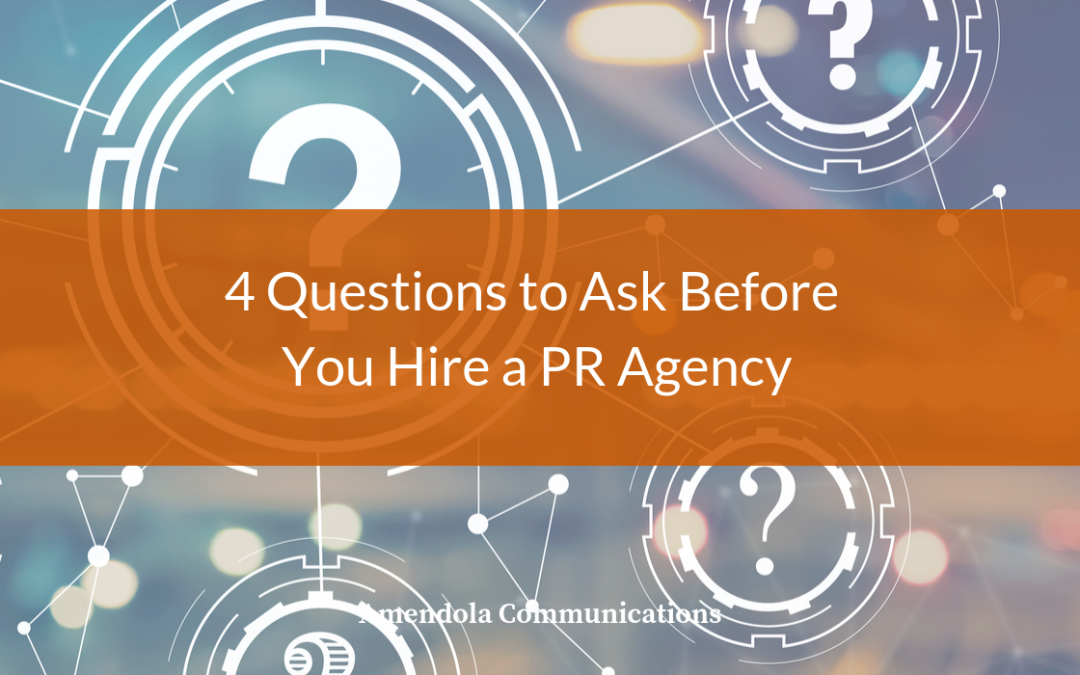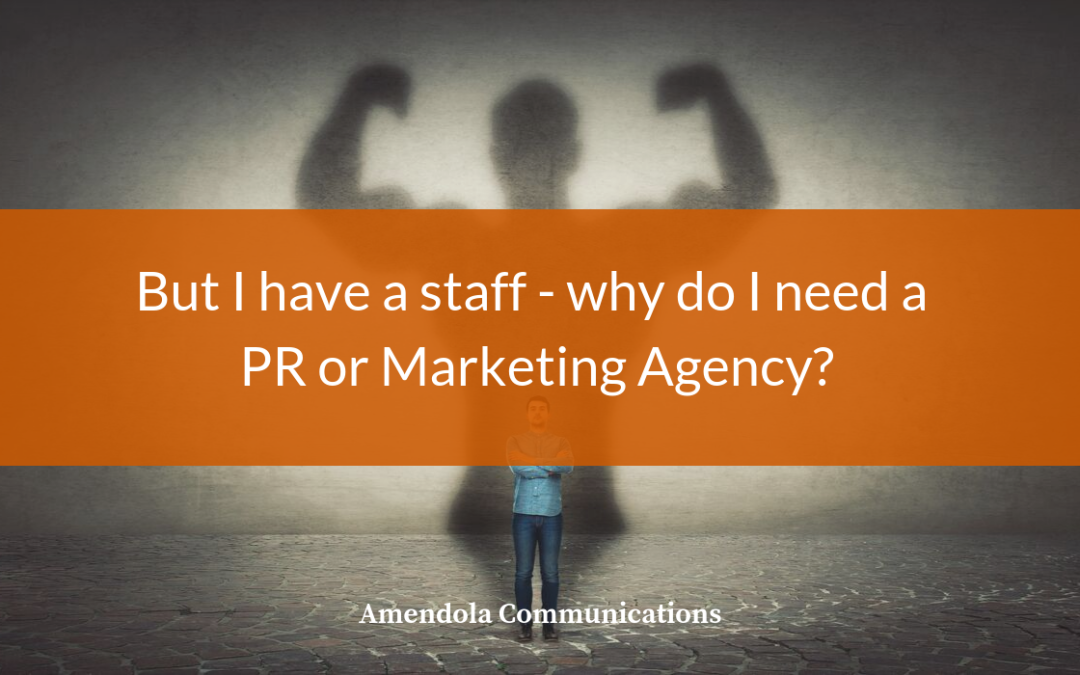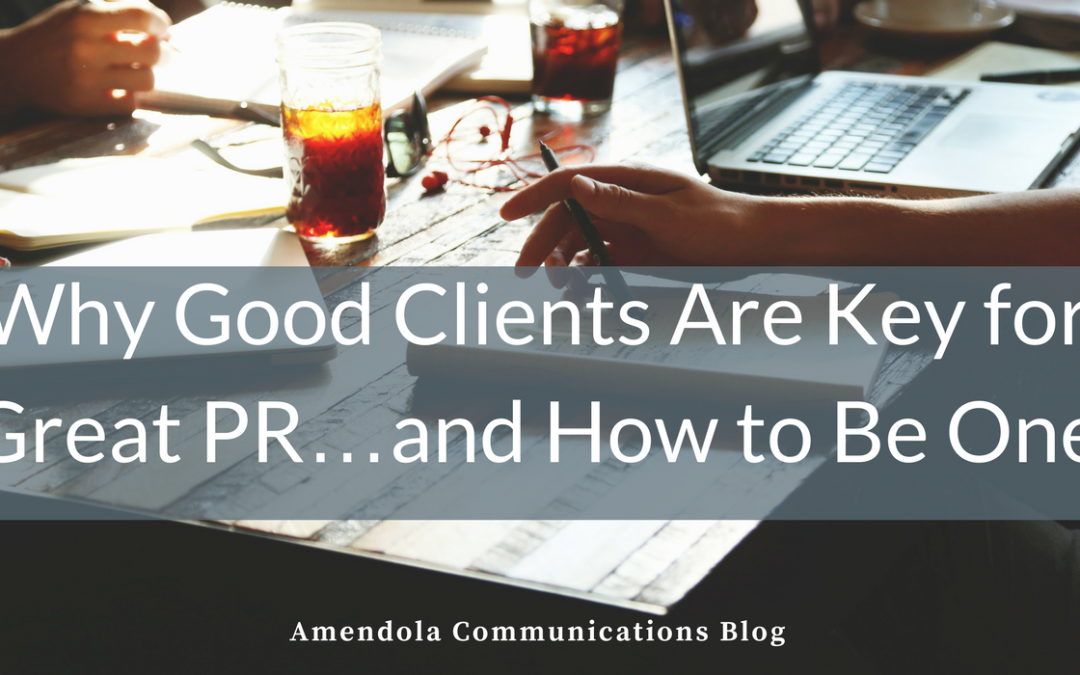by Grant Evans | Aug 18, 2021 | Blog
So, you want to engage a PR agency to help get the word out about your solutions or services.
Sounds like a plan. Sounds easy.
But the process can be daunting, time-consuming, and expensive. And, most importantly, it may not help you achieve your goals.
If this sounds oddly pessimistic coming from someone in an agency, bear with me. I’m here to share some considerations, observations, and best practices gleaned from over three decades split between agency and corporate marketing gigs. Avoiding the mistakes of others can save you time and money, and result in a productive, positive working relationship with your agency.
Know what you want to accomplish.
Do you need straight-up media relations? Industry analyst engagement? Help with messaging and positioning? Social media strategy and support? Editorial and content development? Speaking opportunities? Is there the potential for crisis management? Will your executives require media training?
Having a grasp of your near- and longer-term objectives can help you narrow the field. Most agencies will claim to provide a full menu of such services, but the quality and scope of the offerings can vary wildly. Be skeptical and do your due diligence.
PR Agency? Full-Time Employee? Freelancer?
There are pros and cons to each of these approaches, and your organization’s budget, timeline, and internal processes will dictate the best approach.
Agencies can be expensive, depending on the retainer structure or the billable rates of your account team, but can actually be more cost-effective than the alternatives. They also bring a wealth of expansive and deep marketing expertise, along with a solid bench. They are often very good at helping determine what you need (see above), are responsive and reliable, and 100% dedicated to your agenda. Agencies also provide access to a host of services––from art/creative direction and design, to web development, digital marketing, and social media strategy and support.
Full-time employees are great because they are invested in your success and are in it for the long haul. But they often require substantial budget outlays, and can take months to identify, recruit, sign, and onboard. Once they are thoroughly steeped in your offerings, they can be outstanding brand ambassadors and stewards, and can also work on other marketing initiatives as needed. But once they leave, you’re back to square one.
Freelancers can be nimble hires––they often have excellent credentials, can start right away, and hit the ground running. But they typically operate with minimal resources, have no back-up, and must dedicate hours to other clients. They also can be brutally hard to integrate into existing systems (HR/accounting, project management, content management). They also are prone to terminating their arrangements abruptly (which can also work in your favor if you only need a limited engagement).
One size does not fit all.
Yes, big agencies have big resources, but don’t let claims of a national footprint, local presence, global reach, or head count sell you on an ill-matched relationship. Think expertise, applied experience in your market, and skillsets that dovetail with your agenda. Access to creative resources is a plus. Know how many hours are available to your account each week or month.
Who’s on the team?
This consideration also hinges on knowing what you want to accomplish. If you’re looking for a clip shop to get you mentioned in every low-value round-up article, then seniority matters little. But if you’ll need responsive counsel with expertise in and contacts spanning your market, look for senior-level account team members. Ask the tough questions: What’s the average tenure of your account team? Where have they worked? What companies have they represented? What results have they generated? How many former journalists are on staff? How many accounts do they manage at once?
Mind the old switch-a-roo.
Let’s assume you’re down to a few final candidates and are evaluating pitches. For these meetings, most agencies will send out the big guns––often including the person with his/her name on the door. But will you ever see or hear from these folks again? Many times, agencies get a bad rap by orchestrating a senior executive dog-and-pony show, only to later hand the account over to junior staffers (or even interns) who, while eager, often require more direction and a longer ramp-up period. Get firm commitments on your team’s composition, and don’t hesitate to challenge if you aren’t sold on the match. You want them to operate as an extension of your team.
Beware of scope creep.
Will the agencies you are considering be able to accommodate your needs as your marketing strategy evolves? If your program may eventually require social media support, make sure the agency of record has the capabilities––and not just an intern with a huge stable of Instagram followers, but applied expertise in cultivating an online presence with a custom mix of organic and paid content. Ditto for the media training and crisis communications mentioned earlier. Otherwise, you’ll be saddled with the chore of evaluating and enlisting additional vendors.
In the end, it’s entirely up to you, and highly dependent on your organization’s budget, processes, and requirements. And remember, the old adage, “Fast, cheap, or good? You can only pick two” applies here as well. If you want something fast and good, it won’t be cheap; if you want it cheap and good, it won’t be fast; and if you want cheap and fast, it won’t be good. Choose wisely.

by Philip Anast | Aug 4, 2021 | Blog
While searching for a high-school graduation gift this summer, I came across a book called, “Learn Like a Pro, Science-based tools to become better at anything.” Primarily a guidebook for students about how to learn, study and prepare for tests, it also has application for all who desire maximizing their learning abilities regardless of age.
The authors, Barbara Oakley and Olav Schewe, are university professors who share their failures along the way and how they transformed themselves into skilled learners.
As a PR professional for an award-winning PR and marketing agency, I wanted to give this book a “test drive” to see if it could help me in my own work, as well as provide colleagues with best practices.
One of the methods they recommend is the Pomodoro Technique, where an individual sets aside e-mail, mobile phones and other distractions for 25 minutes of uninterrupted study or work. The technique avails itself of the focused mode of learning, where the brain tackles an assignment or problem intently. After the focused period, the doer takes a five-minute break so that the diffuse mode of learning can continue working in the background while the person listens to music, takes a walk, gets a snack, etc. The idea is to rinse and repeat. The diffuse mode, incidentally, is the part of the brain that spurs creativity.
Focused and diffuse modes of learning help build connections between neurons, the brain’s building blocks. The links between neurons are synapses. The stronger the neural connections, the stronger knowledge, understanding and insights take root in long-term memory.
Exercise also plays a part in these neural connections because it produces a substance called brain-derived neurotrophic factor BDNF, a type of fertilizer for the brain.
The Pomodoro Technique may even mitigate procrastination by giving the user a set amount of time to focus intently on a task with a built-in reward at the end of the period. For those struggling with a particular task, like an essay or math problem, stepping away to do something else allows the diffuse mode to continue pondering the issue at hand. Often, new ideas emerge in our brains when we return to that task.
In a new business presentation, for example, the authors might recommend that team members review materials for one hour a day, every other day, in the week before presenting. The breaks allow the diffuse mode to do its thing. As that presentation day approaches, reviewing materials and rehearsing the presentation grow in frequency.
For the chapters on self-discipline and motivation, who better to reference than Theodore Roosevelt to make their points. In 1912, the former President sustained a bullet wound by a would-be assassin in Milwaukee. The shot missed Roosevelt’s vital organs, and while still bleeding, he continued speaking for over 90 minutes! Roosevelt, from a young age, pushed himself to read, study and exercise at a breath-taking pace. He is said to have read one book a day during his eight years in the White House.
Their point is that not everyone has self-discipline or that type of sheer will. But there are ways to improve one’s chances of success at assignments and getting things done.
The way to do it is by limiting the distractions and temptations that require such self-discipline in the first place. Again, removing mobile phones during focused work, limiting the distractions on one’s desk and workspace are great starts.
To be deep learners, the authors have several recommendations while reading books and other materials: The first is to skim a book chapter or white paper for section headings, executive summaries, graphics and bold-faced copy to get a feel for the material. Later, with focused reading, it’s important to turn your gaze away every few pages to engage in a method called recall (or retrieval), which entails summarizing, in one’s own words, what has been learned. Studies suggest this method of reading breeds greater retention than reading materials repeatedly, where the strong neural connections often don’t form because one hasn’t really absorbed the material.
To aid in this process, the authors recommend taking notes on the right 2/3 of a notebook, leaving the left 1/3 to summarize key words and thoughts later in the day. This helps in the recall/retrieval process.
Another area impacting effective learning and time management is the writing and editing process. The authors assert not to confuse the two. When one is writing, one ought to pour one’s heart into writing without worrying about everything being perfect. It’s essential to get thoughts on paper and digital screen. The editing process takes place later and is more effective as its own discipline.
Setting process, milestone and long-term goals also go a long way to sowing a path to success. To establish goals and fulfill them, one must develop good habits and weed out the bad ones. This exercise can be accomplished by finding the triggers to bad habits and resetting them so that there are positive cues and then rewards at the end of the tunnel.
That’s all for now. My Pomodoro session has now concluded, and it’s time for a break.

by Jodi Amendola | Oct 16, 2019 | Blog
There are many great reasons companies hire a PR agency.
Start-ups often do it to create a “larger than life” image in the marketplace. Having your executives interviewed by top industry trade media, or having your thought leadership published in top publications, helps build brand awareness and elevates the perception of the company’s position in the industry – an important factor when selling against larger, more established competitors. There’s nothing like having an industry analyst tell a small client they thought the client was much larger based on all the publicity they’ve received.
More established organizations may hire a PR agency to help change a negative perception into a positive one. They may do it to help generate sales leads or provide “air cover” for salespeople when they meet with a prospect – especially when the product has a long sales cycle. They may do it to position themselves for an acquisition, because a great PR campaign can help bring them to the attention of larger organizations looking for good companies to purchase.
Yes, there are lots of good reasons to hire a PR agency. But what’s important to understand is that there’s more to it than simply signing a contract and telling the PR agency to go do their thing.
It’s also going to take effort and commitment on the part of the client and its executives.
That’s why I recently wrote a blog post for the Forbes Agency Council titled, “Four Questions to Ask Before You Hire a PR Agency.” It looks at both the strategic and tactical areas organizations should consider before they contract with a PR agency if they want the relationship to be a success. Here’s a quick excerpt from the first question:
“Every business has the same goal: growth. The challenge, of course, is identifying how to get there. That’s why, before engaging with a PR firm, it’s helpful to develop specific goals that you’re looking to accomplish. Maybe it’s acquiring more clients in a new market vertical, establishing your CEO as a thought leader, or polishing up your company’s messaging. Regardless, a PR firm can’t help you reach your objectives if you haven’t first defined them. “
Other areas covered include the corporate culture, the need for a dedicated account liaison and the fact that unlike advertising or self-publishing, where you have total control over when, where and how your story appears, you have to be willing to accept that everything won’t always be to your liking in PR.
If you’re thinking about hiring a PR agency give this article a read. It can help ensure you’re really ready for a PR program – and that you make a good choice.
Or you can just contact me here at Amendola Communications. We’ll help walk you through the process and ensure your program achieves its goals.

by Stacy State | Oct 2, 2019 | Blog
We all have strengths and whether we admit it or not, we all have weaknesses. For one, I can’t seem to make a grilled cheese sandwich without burning at least one side. Lucky for me, there are people that not only cook grilled cheese to perfection, but they’ve done so well they’ve opened entire businesses to support this one simple menu item.
Outsourcing we all do it, nearly every day. I, for one, often “outsource” my cooking whether it be to family members or to nearby restaurants.
According to Dictionary.com, outsourcing is a verb meaning to purchase (goods) or subcontract (services) from an outside supplier or source. Unfortunately, the word “outsourcing” often sparks a negative connotation. In reality, it’s simply working with others to provide goods or services to enable one to focus on their own strengths.
The Benefits of an Agency
In 2017, the entire outsourcing market was worth $89 billion and has only grown since with both large and small companies outsourcing various components of their business. Frequently, companies choose to outsource all or pieces of their marketing and public relations efforts.
Some reasons companies may choose a marketing and PR agency include:
- It can be difficult to find the best talent, at a reasonable price. Hiring an agency that specializes in your field can afford you multiple experts at a lower cost.
- Faster Turnaround. With domain knowledge and available tools, a team of experts can produce results faster.
- Tools and Technology. An agency has access to the latest marketing and public relations tools and technology required to execute flawless campaigns with robust reporting.
- Staying Focused. This is especially true of smaller companies or high-growth companies. If information technology is your specialty, let your teams focus on internal development and support while outsourcing tasks that supplement your company objectives while allowing your team to stay focused on their initiatives.
- Last, but not least it is often more financially viable to outsource all or pieces of marketing and public relations rather than staff an entire team. Depending on a company’s size and growth trajectory, an internal marketing and PR team may consist of 1-2 or as many as 20+ internal employees.
Leaders must remember that it’s not an “all or nothing” scenario. If you have internal teams to handle most of the marketing and PR efforts, but you need the other 20%-40% managed externally, most agencies can fit your specific needs into a customized plan.
How to Decide
Even as a highly regarded marketing and public relations agency, we recognize that outsourcing these critical business needs is not for everyone. In a recent Forbes article, Jodi Amendola of Amendola Communications discusses the four criteria and questions to ask before choosing an “outsourced” marketing and PR agency.
The four most important questions include:
- Do you have clearly defined goals that you want your agency to achieve?
- Do you have someone that can act as your corporate liaison?
- Is your company’s culture accepting of new ideas and concepts?
- Are you okay with not being completely in control?
The last two are of particular importance. Whether you have an internal marketing staff already or will be relying solely on an agency, the culture of the company and willingness to accept an outside agency as part of your team is the key to success. The more you accept an agency as part of your team the easier it is for your employees and the agency to align with the business objectives and achieve goals.
In the most successful relationships, companies perceive their marketing and PR firms as an extension of their own teams. As with the existing marketing associates, agencies must also be held accountable for achieving defined goals and measured on their successes.
In summary, every company has its strengths and weaknesses. Josh Kaufmann, a famous business and entrepreneurship author, once said, “For everything we don’t like to do, there’s someone out there who’s really good, wants to do it and will enjoy it.” If you can find one of those, you’re ahead of the game.

by Jodi Amendola | Aug 23, 2017 | Blog
Last month was atypical for sure. I had two clients call and ask me, “How can we be a better client?” Wow! In all of my years in public relations & marketing, I don’t believe that has ever happened before.
One of the clients actually said, “You’ve always been there for us and have done a great job. I know we are the bottleneck right now. We’ve got to be a better client.”
The second client said he was pleasantly surprised at how much we have accomplished since launching our program, was delighted with the traction and volume, and most definitely wanted to sustain it. He added, “But the last thing we want is to be a difficult client!”
Obviously the Universe is hinting it’s time for a list of tips on being a fantastic client but first, let me underscore how essential it is to partner with a compatible PR agency. I’ve noted before that selecting a PR agency is much like selecting a spouse. For a solid relationship going forward, be sure the foundation rests on good, open, honest communication.
Which leads to my first tip
Have a dedicated Liaison. Having someone on your team who is responsive to deadlines and requests for interviews and information is paramount to our success. If we uncover a media interview, chances are the editor will want to interview your executive or client that day or that week. We need our liaison to respond with availability so we can firm up the interview and prep all parties. Email, phone, text is fine just someone who responds in a timely fashion.
Available/Engaged company and client spokespeople. It is so helpful when the passion, enthusiasm and commitment comes from the top. The positive energy will trickle down. In addition, access to thought leaders helps to shape messaging, priorities and sets the tone for the entire program. We can be more successful when we have ongoing information and communication from your team’s visionaries. On a related note, be sure your company is actually cultivating thought leaders.
Treat us like a member of your team. We are family now, right? We view ourselves as an extension of your team and would like to be in the know on what’s going on. Keep us informed and be transparent. Share your ideas, corporate initiatives, new customers gained, upcoming events, marketing campaigns, and important timelines. Keep the line of communication open and remember, it flows both ways. So ask us for advice, or run ideas by us we love to collaborate with our clients! Please invite us to talk to your internal stakeholders, especially those in product strategy, sales and other key team members. We appreciate consistent, open communications about the company’s business activities, developments, successes, and milestones.
Prep before your media/analyst interviews. We will do our part to arrange a prep for your interviews but please come prepared. We’re here to help with that, too.
Communicate, Communicate, Communicate Communication is the foundation to any relationship. If you are too busy to respond, let us know. If you are going to be out of the office, let us know. If you need extra support because your biggest trade show is coming up, call us NOW. There is no smarter way to leverage an expensive investment in tradeshows than through public relations. If you love our writing, let us know a little positive feedback goes a long way! By the same token if you don’t like the writing style, let us know we have multiple writers and can quickly make a switch. Lastly, we appreciate hearing (and acting!) on your interesting, timely observations, insights and thoughts on industry trends and developments.
Be open to feedback on positioning and strategy for media relations and thought leadership. You are hiring us to provide you with strategic guidance and counsel. You are hiring us for our expertise. And you deserve honesty. We have a great sense for what is newsworthy, what messages resonate and generally what works/what doesn’t. We are not shy. If you are open to it, we will tell you what we really think so ask away!
Set realistic deadlines. In our world, we are used to dealing with fire drills. Everyone wants everything yesterday. However, if you really don’t need the press release by the end of the day, then give us the proper time that is needed to give you something that is top notch.
Bring your positive attitude/energy. PR is one of the most exciting aspects of doing business. We love what we do, especially when we get to work with collaborative, upbeat people. It’s a close relationship, so let’s get comfortable, roll-up our sleeves, and do great things together!



